GEOGRAPHY OF GREECE
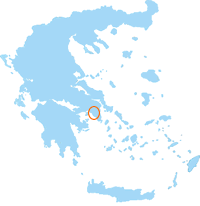 Athens & the Attica region
Athens & the Attica region
Athens is an obligatory 2-3 day stop for any visitor to Greece with “must see” archeological sites and eighty or so museums in the Attica region. The historic center of Athens, the Plaka, has narrow streets, lovingly restored neo-classical buildings and shops selling everything from common tourist souvenirs to exquisite handmade jewelry. When you get tired of shopping and sightseeing stop in one of the many quaint cafes and relax with a bracing doll-size cup of Greek coffee.
Apart from the majestic Acropolis, great sites include the Temple of Zeus and the Greek and Roman agoras, as well as less heralded sites, such as, Socrates Prison and the Pnyx where democracy was born.
Athens lies in the Attica region which an untapped resource of cultural wealth. There are antiquities, such as, the magnificent Temple of Poseidon, as well as Vravrona with the Temple of Artemis. The area has been producing wine for millennia and the family run wineries with indigenous varieties are one of Attica’s most prized features.
Peloponnese and Saronic Gulf islands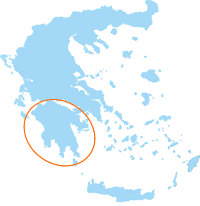
The Peloponnese became an island after the Corinth Canal was completed in 1893 – and you can cycle through it on the Cycle Corinthia tour. Yet since ancient times the Peloponnese always had the feel of an island. Even its name indicates as much, “Island of Pelops,” a famous mythic king. Some of Greece’s most legendary antiquities lie in the Peloponnese which you can experience on the Sacred Sites tour:
• 3rd century BC Epidavros Theatre was one of the largest healing cults in ancient Greece
• Mycenae, home of King Agamemnon who launched the Trojan War
• In Olympia athletes came from all over the ancient world to compete in the global games
• Arcadian mercenary soldiers sought spiritual succor and sustenance at Bassae
The Argo Saronic islands, so close to Athens, make these little gems popular weekend retreats. Car-free Hydra has an elegant artists colony. Aegina, the closest to Athens, is famous for its pistachios. Poros is popular with yachtsmen with its long harbor for docking. Spetses is the last island on the ferry route and so precious with its horse drawn carriages. Salamina, site of Battle of Salamis, has many secluded coves for private swimming. You can see several of these islands are these cruises: Saronic Sailing and Saronic Jewels
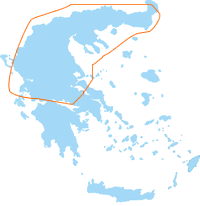 Central Greece and Northern Greece
Central Greece and Northern Greece
Although potential visitors to Greece often imagine islands speckled with white houses and surround by blue seas, in Central Greece you find red tiled roofs in the midst of rich green forests. Here is Ancient Delphi, home of the oracle that Alexander the Great consulted, and Meteora with its amazing Byzantine monasteries perched atop narrow, needle-like rock pillars. The area is a playground for hiking and mountain biking enthusiasts. In Litohoro, there is the highest mountain in Greece, Mount Olympus. Thessaloniki is Greece’s second largest city, and a rich cultural capital that can keep you entertained for days.
When you arrive in the regions of Epirus, Macedonia and Thrace in Northern Greece you are well on your way into the Balkans. Instead of white, cubist-style houses you’ll find majestic wood-framed homes, fireplaces and hearty food. The forty-six Zagoria villages will enchant you with their winding cobblestone streets, mansions with walled courtyards and endearing stone bridges.
Cyclades Islands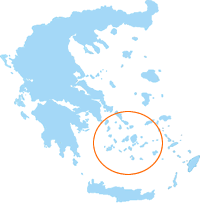
White and Blue. That is the Cyclades Islands. The two colors almost blind you in the summer sun. Cyclades means encircled and refers to islands circling Delos, a sanctuary in ancient Greece. The Cyclades comprise about 220 islands with its capital in Syros.
Each Cycladic island is a picture postcard with endearing scenes like gravity defying monasteries on cliffs, villagers riding side saddle on donkeys, three foot thick walled towers protecting against foreign invaders and octopus hanging on clotheslines to dry.
Santorini is a world class destination famous for its stunning sunsets over the “caldera” (volcano center). It is especially acclaimed for its wines whose grapes are grown in volcanic soil.
Mykonos boasts cosmopolitan glamour and nightly party scenes on sandy beaches. Tinos is a holy island that sees few tourists but many pilgrims flock to its miracle church. Paros only 45 minutes by sea from Naxos, has the delightful Valley of the Butterflies and has terrific cycling routes you can experience on the Cycle Cyclades guided tour. Visit Cyclades islands by taking our other tours: Self Guided Cyclades, South Cyclades Sailing tour, North Cyclades Sailing tour
Other Cyclades Islands:
Andros, Kea, Kythonos, Serifos, Amorgos, Koufonisis, Donousa, Antiparos, Sifnos, Milos, Kimolos, Folegandros, Sikinios, Ios , Anafi.
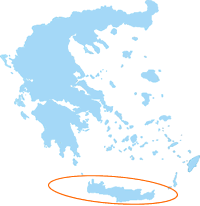 Crete
Crete
Crete, the birthplace of Zeus, is Greece’s largest island. Cretans hold a deep sense of identity as Greeks far more than their fellow countrymen. They have their own foods, music, dancing, wedding customs, myths and dialect. Visiting Crete is almost like going to another country! Crete lies at a strategic point where Europe, Asia and Africa meet.
The Minoan Empire based in Crete was the first civilization on European soil. Visit the palace cities of Knossos, Malia, Zakros and Phaestos on our Captivating Crete cycling tour or Crete Drive & Bike.
Crete has produced an abundance of artists known beyond Greece’s borders. Domenicos Theotokopoulos, better known as El Greco, adopted Spain as his muse. Nikos Kazantzakis, the author of Zorba the Greek and other great Greek novels and Mikis Theodorakis, considered the most important Greek composer of the 20th century.
Crete is a divine destination for nature lovers. The island has several major mountain ranges, tons of hiking gorges, the most caves in Greece and an extensive network of roads and off roads. As the most southern land in Greece, Crete stays warmer longer than any place in Europe with a dry heat and sunshine almost 300 days out of the year.
Dodecanese and Northern Aegean Islands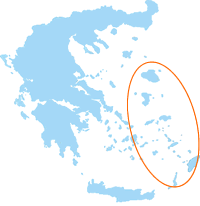
Dodecanese means “Twelve Islands” in Greek, but actually there are sixteen islands, the largest being Rhodes, the Crusader capital. They did not become part of Greece until after World War II. Many older residents still speak fluent Italian from when Italy controlled the territory.
Ancient temples, Crusader castles, Byzantine churches and Ottoman mosques are some of the fascinating remnants of foreign invaders to be found in the Dodecanese. Kos was home to Hippocrates, the Father of Medicine, and his clinic can be visited on our Crusader Paths tour.
The Northern Aegean islands include Samos and Ikaria, Chios and Lesvos. They are less culturally homogenous than the Dodecanese but richly rewarding for the traveler looking for untrampled terrain, unspoilt nature and unfrequented locales. Chios in particular is alluring for its mastic villages whose health product, mastica (as valuable as silver during the Ottoman years), cannot be found anywhere else in the world. Ikaria is the “land where people forget to die” because the islanders’ lifestyle encourages longevity. Visit Lesvos & Chios in our self guided cycling tour.
Dodecanese Islands:
Patmos, Lipsi, Leros, Kalymnos, Kos, Astypalea, Nisyros, Tilos, Symi, Halki, Rhodes
Northern Aegean Islands:
Lesvos, Chios, Samos, Ikaria, Fourni, Limnos, Samothraki, Thasos
 Sporades Islands and Evia
Sporades Islands and Evia
The 11 islands of the Sporades, or “scattered ones” in Greek, lie off the coast of the much larger island, Evia. Only four of the Sporades are inhabited: Skiathos, Skyros, Skopelos, Alonnisos.
Evia, Greece’s second largest island, has gorges with hiking routes and healthy hot springs in Loutro Edipsos. Skiathos is an outdoorsman’s delight with water sports, scuba diving, horse back riding, mountain biking. Skopelos is famous as the island where Mamma Mia was shot. The largest protected marine park in Europe is found in Alonissos where you can see dolphins, sea otters and whales. Less touristed, less developed is Skyros – come here to escape to a slow motion life style.
Ionian Islands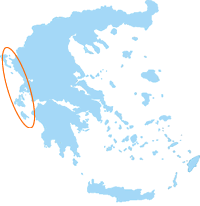
Green and blue are the signature colors of the Ionian islands – green forests highlighted by deep blue seas. Like most of Greece, the Ionians were conquered and occupied by many foreign invaders, including the French, the Turks and the British. Lying so close to Italy made them convenient plunder for Venetian princes and doges. Until this day, the Ionians have an Italian look and influence.
Corfu (a/k/a Kerkyra) captures the Venetian feel most spectacularly. Ithaka is known as the birthplace of Homer and you can find sites there relating to him. Captain Corelli’s Mandolin has put Kefalonia on tourists’ radar and they then discover the island’s marvelous sea caves. Lefkada is a sea sports haven with sea kayaking, wind surfing and sailing. Go to Zakynthos (a/k/a Zante) for dazzling sea caves.






